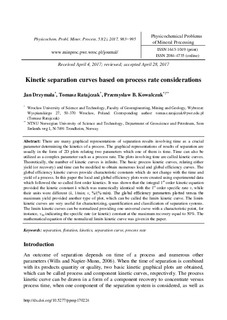Kinetic separation curves based on process rate considerations
Journal article, Peer reviewed
Published version
Permanent lenke
http://hdl.handle.net/11250/2464431Utgivelsesdato
2017Metadata
Vis full innførselSamlinger
Originalversjon
Physicochemical Problems of Mineral Processing. 2017, 53 (2), 983-995. 10.5277/ppmp170224Sammendrag
There are many graphical representations of separation results involving time as a crucial parameter determining the kinetics of a process. The graphical representations of results of separation are usually in the form of 2D plots relating two parameters which one of them is time. Time can also be utilized as a complex parameter such as a process rate. The plots involving time are called kinetic curves. Theoretically, the number of kinetic curves is infinite. The basic process kinetic curves, relating either yield (or recovery) and time can be modified to obtain numerous local and global efficiency curves. The global efficiency kinetic curves provide characteristic constants which do not change with the time and yield of a process. In this paper the local and global efficiency plots were created using experimental data which followed the so-called first order kinetics. It was shown that the integral 1st order kinetic equation provided the kinetic constant k which was numerically identical with the 1st order specific rate v, while their units were different (k, 1/min; v, %/(%·min). The global efficiency parameters plotted versus the maximum yield provided another type of plot, which can be called the limits kinetic curve. The limits kinetic curves are very useful for characterizing, quantification and classification of separation systems. The limits kinetic curves can be normalized providing one universal curve with a characteristic point, for instance, v50 indicating the specific rate (or kinetic) constant at the maximum recovery equal to 50%. The mathematical equation of the normalized limits kinetic curve was given in the paper.
